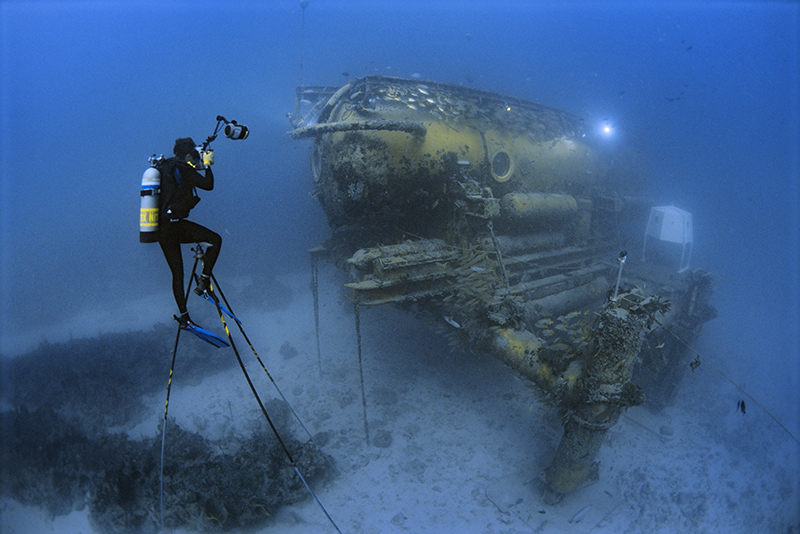Nat Geo Live – the series of talks by leading photographers working for the periodical – is slated to bring another world-class professional to our shores to excite and educate. This time around, National Geographic underwater photographer Brian Skerry will take to the stage to showcase his 30-year career which focused on underwater photography, conservation and oceanography. He has not only covered stories that have bought to global attention the dire situation of unsustainable fishing practices, depletion of the seas, but also stories where solutions are offered and a glimmer of hope shines through.
I was fortunate to be able to speak with this inspiring person over the phone to find out a little about him, his views on conservation and a little on photographic technique. (View video above for full conversation.)
Asia 361: In the course of your work, you assume many professions such as journalist, diver, photographer. Which came first and how did you come to pick up all the other disciplines?
Brian: I was an explorer first, and then I became a diver and got interested in photography. To become a Nat Geo photographer was my dream and I went to university to take up media studies. After school, I started selling my photography and in the mean time learnt how to apply my training to an underwater environment. All the while, I was building up my portfolio and eventually was noticed by Nat Geo.
Asia 361: Who were your influences?
Brian: Once I set the goal of being an underwater photographer, I looked towards Bill Curtsinger and David Doubilet who were doing it in the day. I also followed Chris John and Jim Brandenburg who are wildlife photogaphers.
Asia 361: What is your style?
Brian: A mix of reportage and aesthetics.
Asia 361: What were your memorable moments?
Brian: A story on overfishing and the depletion of ocean resources. It was very depressing and eye-opening. It hit me deeply and awoke me to the serious problems facing the planet today. I spent two years working on that story and there wasn’t any good news. However, after that, I did a story on marine conservation and that was refreshing as it showed me the potential solutions.

Brian Skerry sits atop a 20 foot high underwater tripod to photograph the Aquarius Habitat off Key Largo, Florida. Skerry lived inside this habitat in saturation for seven days. Photo © Mark Conlin.
Asia 361: Was this when you became interested in conservation?
Brian: Not exactly, I was interested before when I did a story on harp seals in 2002. Initially I just wanted to cover the migration of these animals, but I discovered the environmental issues involved and felt an ability to include topics related to conservation in the story. However, I realised I could not just show the negative side of the stories; I also have to show the positive side to show people what we have and why it is worth preserving.
Asia 361: How do you approach a story holistically, as ocean issues usually start on the land?
Brian: Lengthy research and good preparation.
Asia 361: Is photography still a good force for change?
Brian: I do, as humans are visual creatures. It is apparent in the explosion of social media. A picture paints a thousand words.

Spotted Dolphins (Stenella frontalis) in the waters around Bimini in the Bahamas. Photo © Brian Skerry.
Asia 361: What are the challenges of underwater photography?
Brian: Limited time, technical limitations such as not being able to change lenses and memory cards. I can’t use telephoto lenses and have to photograph subjects up close. I am also more affected by weather changes. It’s somewhat like portraiture.
Asia 361: Describe a typical shoot. What are the most important considerations?
Brian: A usual day is 18 hours long; you have to wake up very early. It’s a long day, and you try to spend as much time as possible with your subject. Access is the biggest challenge – how much time you have with your subject, months on end. Its physically and mentally exhausting.
Good lighting and finding a graceful image are my most important considerations.
Asia 361: What is your “go to” gear?
Brian: I like my 17-35mm zoom lens. With that I can capture most scenarios. I would also bring two strobes.
Asia 361: What advice would you give to other photographers who want to do what you do?
Brian: Have a lot of passion and patience. It can get tiring and lonely. Also have a unique, focused portfolio. Set goals and work towards them. Work in places where you can keep going back to, you don’t need to scoot off to faraway places. As a local working in your local environment, you have more time and ability to produce better work.
Brian Skerry will be in Singapore on 24 January 2016 for the event “National Geographic Presents: Ocean Wild with Brian Skerry”.
What: National Geographic presents : Ocean Wild with Brian Skerry
Where: Esplanade Theatres by the Bay, Concert Hall, Singapore
When: 24 January 2016
Tickets: For more information on ticketing, visit http://events.nationalgeographic.com/speakers/2016/01/24/ocean-wild-sing/.



![[REVIEW] 1-Group Switches Out Au Balcon for il Giardino at the Singapore Botanic Gardens](https://asia361.com/wp-content/uploads/2025/07/IMG_2036-214x140.jpg)
